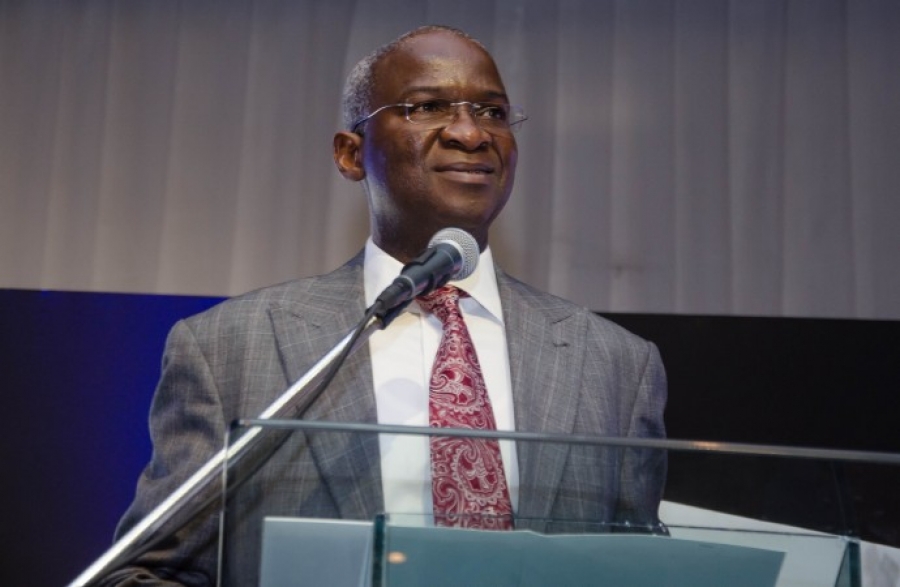Markets
Fashola Assures Sector Operators, Stakeholders of Improved Power, Gas Supply in 2017
Published
8 years agoon

- Fashola Assures Sector Operators, Stakeholders of Improved Power, Gas Supply in 2017
The Minister of Power, Works and Housing, Mr. Babatunde Fashola SAN, has asked stakeholders in the Power Sector to look forward to the implementation of policies that would improve gas supply and liquidity as well as the completion of several power projects by the Federal Government in 2017.
Fashola, while making his Opening Address as Guest Speaker at the January edition of the Nextier Power Dialogue held at the Thought Pyramid Art Centre, said the Ministry of Power, Works and Housing along with other agencies of the Federal Government, like Ministry of Finance and the World Bank, had put together a policy framework that would help establish stronger and better institutional framework needed to tackle the challenges in the Power Sector.
According to the Minister, such policies would help realise a deepening of metering, sanctions for energy theft and better contract performance from Operators in the Power Sector as well as help achieve the financial strengthening of the Nigerian Bulk Energy Trading PLC (NBET).
He explained that he could not discuss the policies yet in details at the event because they were in the process of being presented for consideration and approval by the Federal Executive Council, but however, assured that when implemented, they would take the nation to more gas and assure payment to gas suppliers and generation companies which was the way forward.
He told his audience, “Clearly these policies constitute the way forward and ensures that everybody in the system gets paid. If we have that, at least, we can be sure that those who are supplying gas will not be shutting down because their creditors are pulling them. Then we go to the other side that are angry to see what we can do because gas problem is exacerbated on both sides”.
While explaining the current decreased power supply and outages across the country, he blamed the sabotage of gas pipelines by “some of our angry brothers”, adding that because of the debt owed gas companies by the DisCos, the companies also withheld supply of gas.
The Minister, who noted that there had been some outages across the country in the last 24 hours, however, assured Nigerians that himself, the Permanent Secretary and other officials of the Ministry were trying to see what they could do to address the situation.
Emphasising the need to increase liquidity in the sector, Fashola explained that as a result of the frequent power outages due to the sabotage of power assets, the operators along the power chain were being owed as distribution companies could not pay generating companies who equally could not pay gas suppliers who, in turn, could not pay their bankers.
The Minister pointed out that the debts had been accumulating since 2015 leading to gas companies currently shutting their tanks and forcing power again down to 2,000MW.
In line with increasing liquidity in the sector, Fashola also said Government intended to quickly complete the audit of its Ministries, Departments and Agencies (MDAs) to enable it pay proven debts owed the Operators in the sector adding that the payment had been delayed as a result of lack of authentic debt figures.
The Minister further explained, “You have heard that Federal Government is owing and all that; but you know, we don’t have the authentic figures and until we have that I cannot go and tell President Buhari that we want to pay ‘about…’. He will say we are not serious. So we expect to see the completion of that so that we can pay what is proven debt”.
According to him, Government also intended to see to the financial strengthening of the Nigerian Energy Bulk Trading (NBET), the bulk trader who stands as the interim partner to ensure that everybody that was doing their part in the system was paid, adding that once that was achieved Government would then insist on better contract performance and sanctions for non-compliance.
On calls for the cancellation of the Privatisation contract in the Power Sector, he reiterated his averseness to the call arguing that the country would by such action be sending negative signals to foreign investors that she had no respect for agreements.
Fashola pointed out that the action would only take the nation backward, adding that the programme was just three years old and needed time to mature, as, “We should think on what to do to make it work better instead of cancelling it”.
On what to expect in the New Year in terms of projects aimed at increasing power supply, he listed the Kudenda Transmission Project in Kaduna, which he said would be completed shortly as well as other power assets in Lagos, Sokoto and many more across the country.
According to him, “There are many power projects that will come on stream this year like the Gurara hydro power that we should begin to benefit from it by the end of this quarter because the power plant has been completed remaining just to transmit to Kudenda in Kaduna. Katsina Wind Mill will also be completed this year; the equipment for the completion have left Europe for Nigeria. Kaduna’s 215MW will also come on stream this year, and few others”.
Expected this year also in the power sector, the Minister continued, was better governance and regulation in stronger institutional frameworks as the Nigerian Energy Regulatory Commission (NERC), the regulators in the Sector, was being strengthened to do its work better and more efficiently.
Fashola declared, “They (the NERC Chairman and Commissioners) are the ones doing some of the things you have asked me to come and do; loss reduction, more sanctions for energy theft, more metering and more audit of DisCos to see what their books looked like would be expected this year as well.
“In the last one year that we have been in office, we have got to an all-time high of 5074MW. Nigeria has never reached there before. But immediately we got that, do you know what happened? They started breaking the gas pipelines one by one. We had 14 attacks in about two months.
“We need to get power from wherever we can. So, we said the first step is Incremental Power wherever we could get it; as long as it is legitimate, it is safe, it is environmentally compliant, we would put it on. But some of our brothers are angry; and I continue to tell them anger is not a strategy”, he said adding, however, “I know they will not be angry forever”.
He appealed for peace and understanding among the “angry brothers”, appealed to their relations and friends to persuade them to embrace peace adding, “While they are angry, they are punishing us, they are punishing themselves, they are punishing everybody”.
“You hear us announcing that we commissioned one transmission project or the other, you see me going round for these commissioning; that is the Grid evolving. Today, at its most frugal, it would support 6,500MW; pushed to its limit it would carry 7,200MW. So it is not true when you hear that the grid capacity is not more than 5,000MW. It is growing every day and more projects are coming up. We have completed some and more are still coming up. So that is where we are.
“Now it means that notionally, if we had those 3,000MW plus 4,000MW we were already at 7,000MW. But we would not have it because some of our family members are angry because of the problems, power came down to about 2,000MW and once the power goes below 3,000MW, the Grid would begin to react”, he said.
The Minister decried the lack of accurate demographic data in the country, which according to him, had both resulted in improper planning and hampered the delivery of electricity in the country over the years adding that it was important to know the accurate population of the country in order to know how much power to provide, and the number of consumers to be supplied electricity.
On rural electrification, Fashola revealed that the existing contracts for 2000 constituency electricity projects under the Rural Electrification Agency (REA) would soon be completed, adding that the government would be looking at expanding the generation, transmission and distribution aspects within the electricity value chain by encouraging more technical partners and other investors to come into the power sector and explore other energy resources in more secured environments across the country.
Is the CEO and Founder of Investors King Limited. He is a seasoned foreign exchange research analyst and a published author on Yahoo Finance, Business Insider, Nasdaq, Entrepreneur.com, Investorplace, and other prominent platforms. With over two decades of experience in global financial markets, Olukoya is well-recognized in the industry.

You may like
-


Nigeria’s GDP Records 3.46% Growth in Q3 Spurred by Non-Oil Sector
-


President Tinubu Presents N47.9trn 2025 Budget As Debt Servicing, Security, Infrastructure Take Lion Shares
-


I’m Not Nigeria’s PR, UK Party Leader, Kemi Badenoch, Tells Shettima
-


Nigeria and France Forge Strategic Alliance to Boost Solid Minerals Sector
-


Zhongshang Fucheng Moves to Auction Nigerian Properties in UK Following $70M Arbitration Award
-


Nigerians and Indians Lead UK Job Market Growth Amid Post-Brexit Migration Shifts









